2013 KIA Sportage oil
[x] Cancel search: oilPage 7 of 387
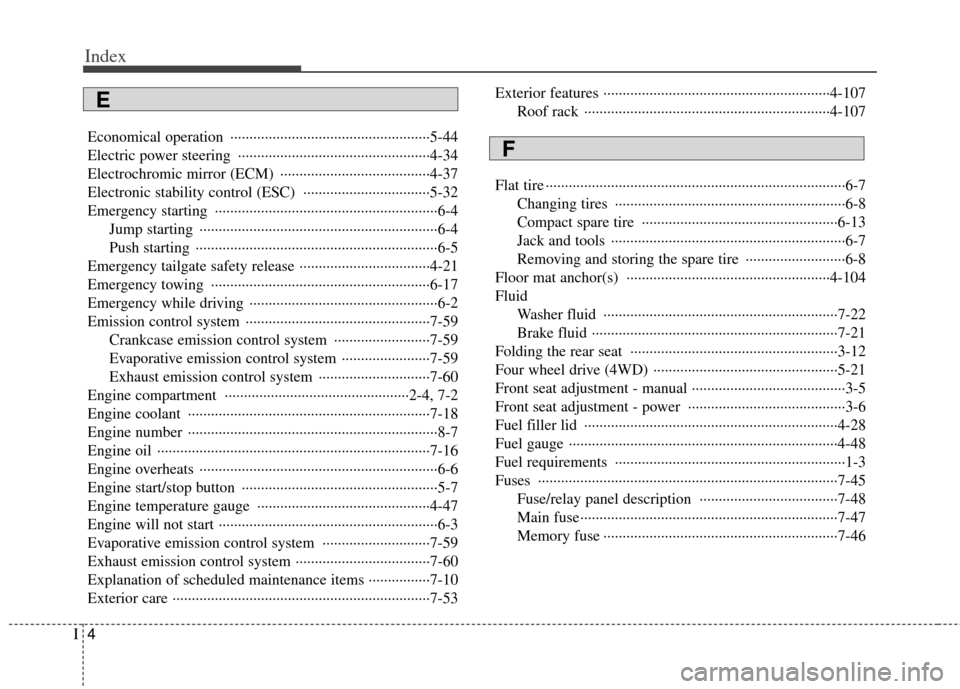
Index
4I
Economical operation ··················\
··················\
················5-44
Electric power steering ··················\
··················\
··············4-34
Electrochromic mirror (ECM) ··················\
··················\
···4-37
Electronic stability control (ESC) ··················\
···············5-32
Emergency starting ··················\
··················\
··················\
····6-4Jump starting ··················\
··················\
··················\
········6-4
Push starting ··················\
··················\
··················\
·········6-5
Emergency tailgate safety release ··················\
················4-21
Emergency towing ··················\
··················\
··················\
···6-17
Emergency while driving ··················\
··················\
·············6-2
Emission control system ··················\
··················\
············7-59 Crankcase emission control system ··················\
·······7-59
Evaporative emission control system ··················\
·····7-59
Exhaust emission control system ··················\
···········7-60
Engine compartment ··················\
··················\
············2-4, 7-2
Engine coolant ··················\
··················\
··················\
·········7-18
Engine number ··················\
··················\
··················\
···········8-7
Engine oil ··················\
··················\
··················\
·················7-16\
Engine overheats ··················\
··················\
··················\
········6-6
Engine start/stop button ··················\
··················\
···············5-7
Engine temperature gauge ··················\
··················\
·········4-47
Engine will not start ··················\
··················\
··················\
···6-3
Evaporative emission control system ··················\
··········7-59
Exhaust emission control system ··················\
·················7-60\
Explanation of scheduled maintenance items ········\
········7-10
Exterior care ··················\
··················\
··················\
·············7-53 Exterior features ··················\
··················\
··················\
·····4-107
Roof rack ··················\
··················\
··················\
··········4-107
Flat tire ··················\
··················\
··················\
··················\
······6-7 Changing tires ··················\
··················\
··················\
······6-8
Compact spare tire ··················\
··················\
···············6-13
Jack and tools ··················\
··················\
··················\
·······6-7
Removing and storing the spare tire ··················\
········6-8
Floor mat anchor(s) ··················\
··················\
·················4-10\
4
Fluid Washer fluid ··················\
··················\
··················\
·······7-22
Brake fluid ··················\
··················\
··················\
··········7-21
Folding the rear seat ··················\
··················\
··················\
3-12
Four wheel drive (4WD) ··················\
··················\
············5-21
Front seat adjustment - manual ···········\
··················\
···········3-5
Front seat adjustment - power ··················\
··················\
·····3-6
Fuel filler lid ··················\
··················\
··················\
············4-28
Fuel gauge ··················\
··················\
··················\
················4-48
Fuel requirements ··················\
··················\
··················\
······1-3
Fuses ·················\
··················\
··················\
··················\
·······7-45 Fuse/relay panel description ··················\
··················\
7-48
Main fuse··················\
··················\
··················\
·············7-47
Memory fuse ··················\
··················\
··················\
·······7-46
E
F
Page 10 of 387
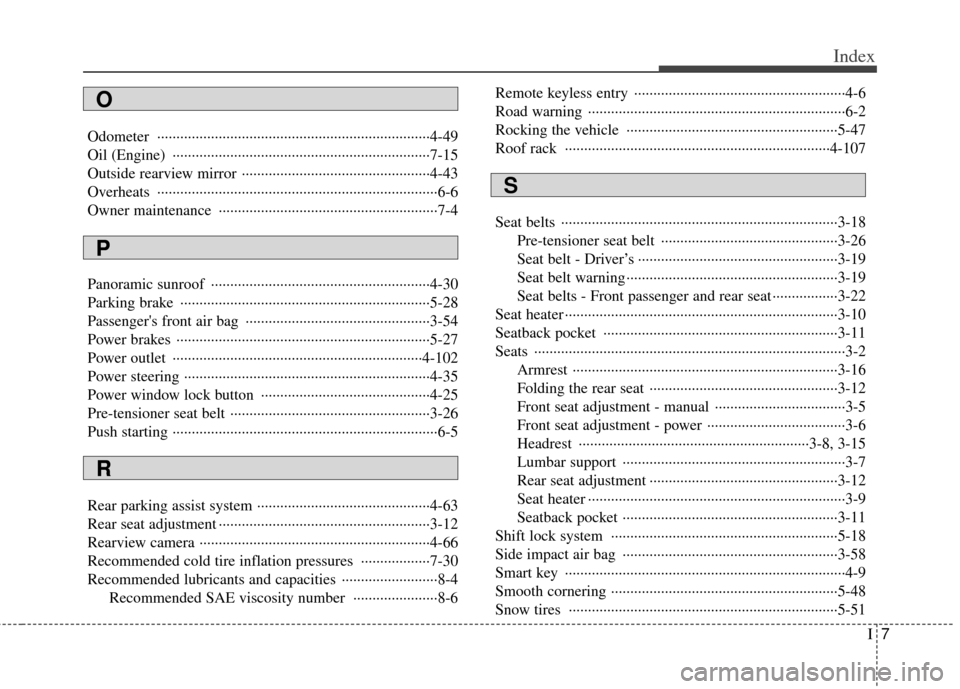
I7
Index
Odometer ················\
··················\
··················\
··················\
·4-49
Oil (Engine) ··················\
··················\
··················\
·············7-15
Outside rearview mirror ··················\
··················\
·············4-43
Overheats ················\
··················\
··················\
··················\
···6-6
Owner maintenance ··················\
··················\
··················\
···7-4
Panoramic sunroof ··················\
··················\
··················\
···4-30
Parking brake ··················\
··················\
··················\
···········5-28
Passenger's front air bag ··················\
··················\
············3-54
Power brakes ··················\
··················\
··················\
············5-27
Power outlet ··················\
··················\
··················\
···········4-102
Power steering ··················\
··················\
··················\
··········4-35
Power window lock button ··················\
··················\
········4-25
Pre-tensioner seat belt ··················\
··················\
················3-26
Push starting ··················\
··················\
··················\
···············6-5
Rear parking assist system ··················\
··················\
·········4-63
Rear seat adjustment ··················\
··················\
··················\
·3-12
Rearview camera ··················\
··················\
··················\
······4-66
Recommended cold tire inflation pressures ··················\
7-30
Recommended lubricants and capacities ··················\
·······8-4Recommended SAE viscosity number ··················\
····8-6 Remote keyless entry ··················\
··················\
··················\
·4-6
Road warning ··················\
··················\
··················\
·············6-2
Rocking the vehicle ··················\
··················\
··················\
·5-47
Roof rack ··················\
··················\
··················\
···············4-107
Seat belts ··················\
··················\
··················\
··················\
3-18
Pre-tensioner seat belt ··················\
··················\
··········3-26
Seat belt - Driver’s ··················\
··················\
················3-19
Seat belt warning ··················\
··················\
··················\
·3-19
Seat belts - Front passenger and rear seat ·················3-22\
Seat heater ··················\
··················\
··················\
·················3-10\
Seatback pocket ··················\
··················\
··················\
·······3-11
Seats ·················\
··················\
··················\
··················\
··········3-2 Armrest ················\
··················\
··················\
·················3-16\
Folding the rear seat ··················\
··················\
·············3-12
Front seat adjustment - manual ··················\
················3-5
Front seat adjustment - power ··················\
··················\
3-6
Headrest ················\
··················\
··················\
········3-8, 3-15
Lumbar support ··················\
··················\
··················\
····3-7
Rear seat adjustment ··················\
··················\
·············3-12
Seat heater ··················\
··················\
··················\
·············3-9
Seatback pocket ··················\
··················\
··················\
··3-11
Shift lock system ··················\
··················\
··················\
·····5-18
Side impact air bag ··················\
··················\
··················\
··3-58
Smart key ··················\
··················\
··················\
··················\
·4-9
Smooth cornering ··················\
··················\
··················\
·····5-48
Snow tires ··················\
··················\
··················\
················5-51
O
P
S
R
Page 18 of 387
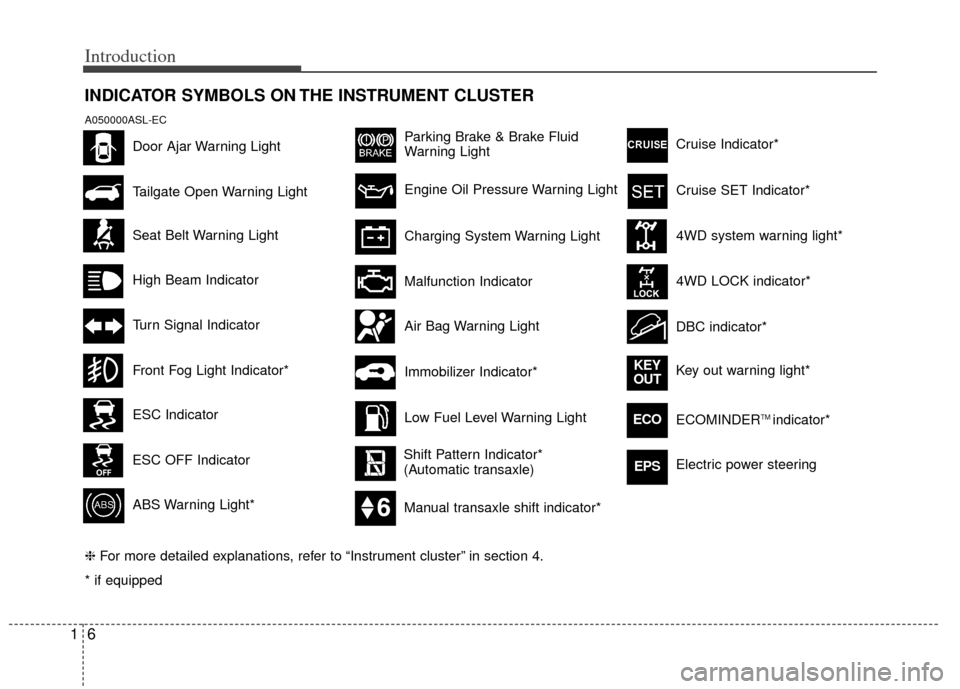
Introduction
61
INDICATOR SYMBOLS ON THE INSTRUMENT CLUSTER
Seat Belt Warning Light
Turn Signal Indicator
ABS Warning Light*
Parking Brake & Brake Fluid
Warning Light
Malfunction Indicator
Low Fuel Level Warning Light
* if equipped Tailgate Open Warning Light
❈ For more detailed explanations, refer to “Instrument cluster” in section 4.
Charging System Warning Light
Door Ajar Warning Light
A050000ASL-EC
Front Fog Light Indicator*
Engine Oil Pressure Warning Light
Air Bag Warning Light
Shift Pattern Indicator*
(Automatic transaxle)
ESC Indicator
ESC OFF Indicator Cruise Indicator*
4WD system warning light*
4WD LOCK indicator*
DBC indicator*
Key out warning light*
KEY
OUT
ECOECOMINDERTM indicator*
Cruise SET Indicator*
High Beam Indicator
Manual transaxle shift indicator*
Electric power steeringEPS
Immobilizer Indicator*
Page 22 of 387
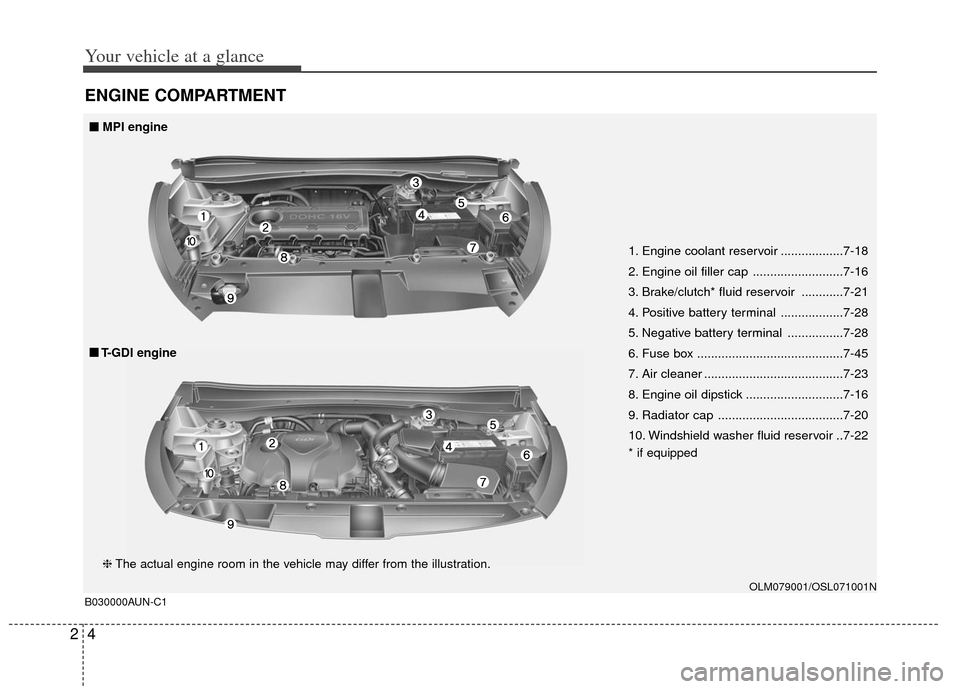
Your vehicle at a glance
42
ENGINE COMPARTMENT
B030000AUN-C1
1. Engine coolant reservoir ..................7-18
2. Engine oil filler cap ..........................7-16
3. Brake/clutch* fluid reservoir ............7-21
4. Positive battery terminal ..................7-28
5. Negative battery terminal ................7-28
6. Fuse box ..........................................7-45
7. Air cleaner ........................................7-23
8. Engine oil dipstick ............................7-16
9. Radiator cap ....................................7-20
10. Windshield washer fluid reservoir ..7-22
* if equipped
OLM079001/OSL071001N
❈The actual engine room in the vehicle may differ from the illustration.
■
■
MPI engine
■
■ T-GDI engine
Page 40 of 387
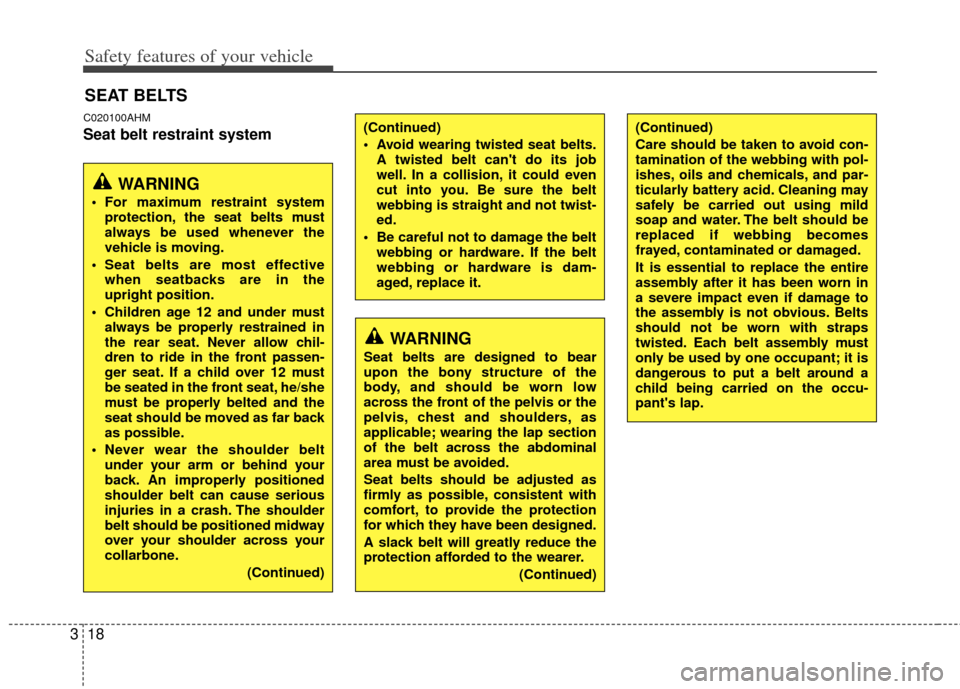
Safety features of your vehicle
18
3
SEAT BELTS
C020100AHM
Seat belt restraint system
WARNING
For maximum restraint system
protection, the seat belts must
always be used whenever the
vehicle is moving.
Seat belts are most effective when seatbacks are in the
upright position.
Children age 12 and under must always be properly restrained in
the rear seat. Never allow chil-
dren to ride in the front passen-
ger seat. If a child over 12 must
be seated in the front seat, he/she
must be properly belted and the
seat should be moved as far back
as possible.
Never wear the shoulder belt under your arm or behind your
back. An improperly positioned
shoulder belt can cause serious
injuries in a crash. The shoulder
belt should be positioned midway
over your shoulder across your
collarbone.
(Continued)
(Continued)
Avoid wearing twisted seat belts.A twisted belt can't do its job
well. In a collision, it could even
cut into you. Be sure the belt
webbing is straight and not twist-
ed.
Be careful not to damage the belt webbing or hardware. If the belt
webbing or hardware is dam-
aged, replace it.(Continued)
Care should be taken to avoid con-
tamination of the webbing with pol-
ishes, oils and chemicals, and par-
ticularly battery acid. Cleaning may
safely be carried out using mild
soap and water. The belt should be
replaced if webbing becomes
frayed, contaminated or damaged.
It is essential to replace the entire
assembly after it has been worn in
a severe impact even if damage to
the assembly is not obvious. Belts
should not be worn with straps
twisted. Each belt assembly must
only be used by one occupant; it is
dangerous to put a belt around a
child being carried on the occu-
pant's lap.
WARNING
Seat belts are designed to bear
upon the bony structure of the
body, and should be worn low
across the front of the pelvis or the
pelvis, chest and shoulders, as
applicable; wearing the lap section
of the belt across the abdominal
area must be avoided.
Seat belts should be adjusted as
firmly as possible, consistent with
comfort, to provide the protection
for which they have been designed.
A slack belt will greatly reduce the
protection afforded to the wearer.
(Continued)
Page 145 of 387
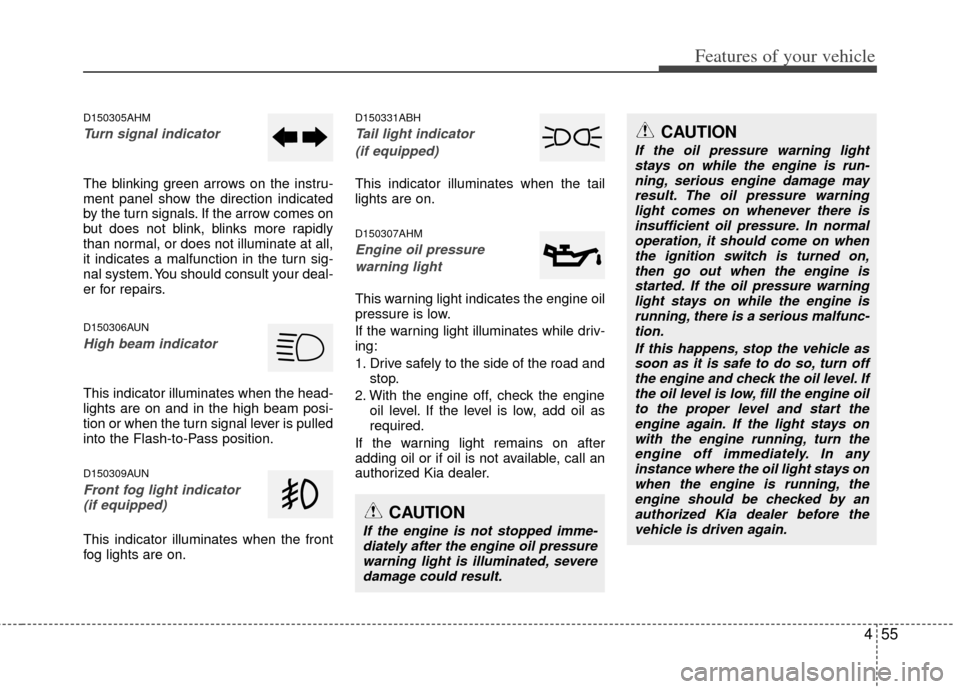
455
Features of your vehicle
D150305AHM
Turn signal indicator
The blinking green arrows on the instru-
ment panel show the direction indicated
by the turn signals. If the arrow comes on
but does not blink, blinks more rapidly
than normal, or does not illuminate at all,
it indicates a malfunction in the turn sig-
nal system. You should consult your deal-
er for repairs.
D150306AUN
High beam indicator
This indicator illuminates when the head-
lights are on and in the high beam posi-
tion or when the turn signal lever is pulled
into the Flash-to-Pass position.
D150309AUN
Front fog light indicator (if equipped)
This indicator illuminates when the front
fog lights are on.
D150331ABH
Tail light indicator
(if equipped)
This indicator illuminates when the tail
lights are on.
D150307AHM
Engine oil pressure warning light
This warning light indicates the engine oil
pressure is low.
If the warning light illuminates while driv-
ing:
1. Drive safely to the side of the road and stop.
2. With the engine off, check the engine oil level. If the level is low, add oil as
required.
If the warning light remains on after
adding oil or if oil is not available, call an
authorized Kia dealer.
CAUTION
If the engine is not stopped imme- diately after the engine oil pressurewarning light is illuminated, severedamage could result.
CAUTION
If the oil pressure warning lightstays on while the engine is run-ning, serious engine damage may result. The oil pressure warninglight comes on whenever there isinsufficient oil pressure. In normal operation, it should come on whenthe ignition switch is turned on, then go out when the engine isstarted. If the oil pressure warning light stays on while the engine isrunning, there is a serious malfunc-tion.
If this happens, stop the vehicle assoon as it is safe to do so, turn offthe engine and check the oil level. If the oil level is low, fill the engine oilto the proper level and start the engine again. If the light stays onwith the engine running, turn theengine off immediately. In any instance where the oil light stays onwhen the engine is running, theengine should be checked by an authorized Kia dealer before thevehicle is driven again.
Page 177 of 387
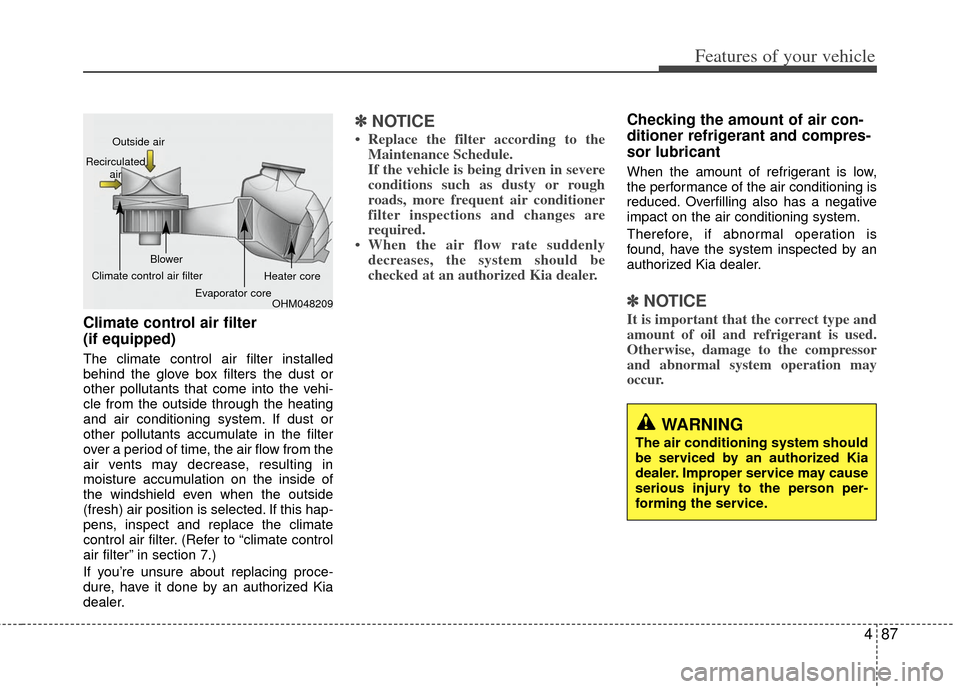
487
Features of your vehicle
Climate control air filter
(if equipped)
The climate control air filter installed
behind the glove box filters the dust or
other pollutants that come into the vehi-
cle from the outside through the heating
and air conditioning system. If dust or
other pollutants accumulate in the filter
over a period of time, the air flow from the
air vents may decrease, resulting in
moisture accumulation on the inside of
the windshield even when the outside
(fresh) air position is selected. If this hap-
pens, inspect and replace the climate
control air filter. (Refer to “climate control
air filter” in section 7.)
If you’re unsure about replacing proce-
dure, have it done by an authorized Kia
dealer.
✽ ✽NOTICE
• Replace the filter according to the
Maintenance Schedule.
If the vehicle is being driven in severe
conditions such as dusty or rough
roads, more frequent air conditioner
filter inspections and changes are
required.
• When the air flow rate suddenly decreases, the system should be
checked at an authorized Kia dealer.
Checking the amount of air con-
ditioner refrigerant and compres-
sor lubricant
When the amount of refrigerant is low,
the performance of the air conditioning is
reduced. Overfilling also has a negative
impact on the air conditioning system.
Therefore, if abnormal operation is
found, have the system inspected by an
authorized Kia dealer.
✽ ✽ NOTICE
It is important that the correct type and
amount of oil and refrigerant is used.
Otherwise, damage to the compressor
and abnormal system operation may
occur.
WARNING
The air conditioning system should
be serviced by an authorized Kia
dealer. Improper service may cause
serious injury to the person per-
forming the service.
OHM048209
Outside air
Recirculated air
Climate control air filter Blower
Evaporator core Heater core
Page 195 of 387
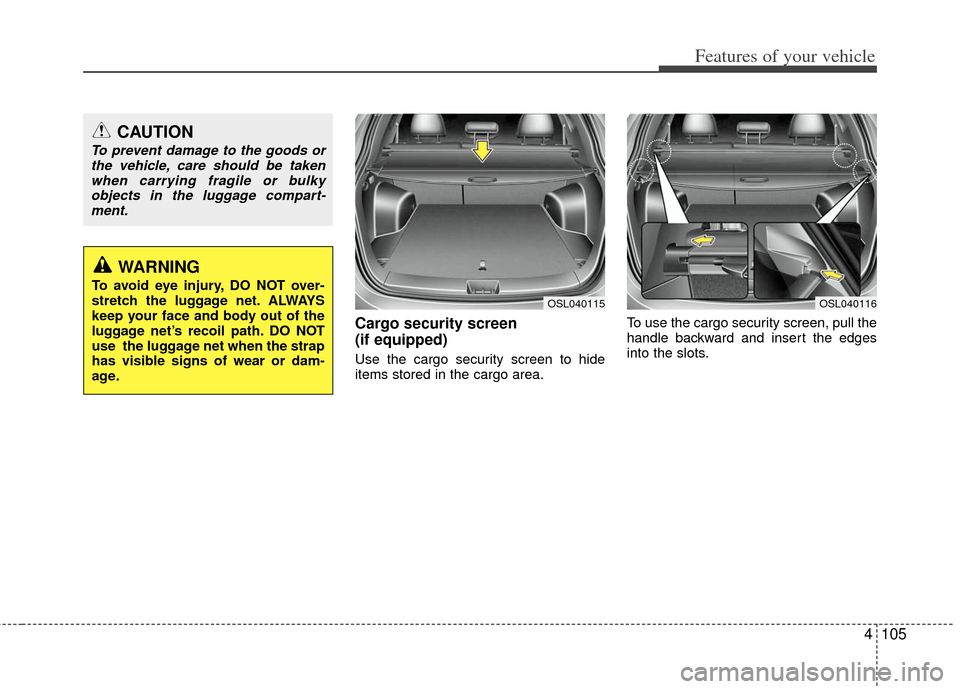
4105
Features of your vehicle
Cargo security screen
(if equipped)
Use the cargo security screen to hide
items stored in the cargo area.To use the cargo security screen, pull the
handle backward and insert the edges
into the slots.
CAUTION
To prevent damage to the goods or
the vehicle, care should be takenwhen carrying fragile or bulkyobjects in the luggage compart-ment.
WARNING
To avoid eye injury, DO NOT over-
stretch the luggage net. ALWAYS
keep your face and body out of the
luggage net’s recoil path. DO NOT
use the luggage net when the strap
has visible signs of wear or dam-
age.
OSL040116OSL040115